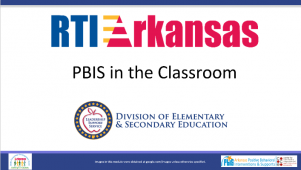Students spend most of their school days in the classroom. By implementing effective PBIS classroom practices, learning can be maximized and discipline problems can be minimized.
The universal, or Tier I components of school-wide PBIS can be implemented in the classroom setting. Using the school-wide behavioral expectations, teachers can define, teach, model, and reinforce behaviors in their classrooms. Teachers can develop a classroom matrix of behavioral expectations, similar to matrices in common areas of the school, but defined in the context of each particular classroom. For example, Be Responsible in the classroom may be defined as having appropriate materials, being on time, or turning in homework on time. Be Safe in the science lab may look very different than Be Safe in the choir room.
The same guidelines for developing school-wide expectations apply to developing classroom expectations. The expectations, rules, procedures are all observable, measurable, positively-stated, easy to understand, and always applicable. Teachers spend time teaching, practicing and reinforcing the expectations and procedures at the beginning of the school year, giving reminders and boosters as needed. This gives students a more positive, predictable environment and teachers will spend less time correcting misbehavior throughout the school year.
The other important components of PBIS involve responding to problem behavior and data-based decision making. When students make a behavioral mistake, it is typically because they either have a skill deficit or a lack of motivation to use the expected behavior. It’s important for teachers to have strategies to address and manage minor mistakes so that the behavior is corrected and the student is encouraged to use the correct behavior. And as with school-wide PBIS, it is important to collect and use data to inform decisions and help teachers monitor classroom-wide behavior, as well as individual student behavior.


